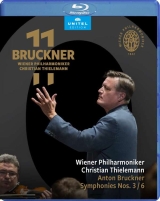Mit den Symphonien Nr. 3 und 6 setzt Christian Thielemann seinen bislang hochkarätigen Bruckner-Zyklus mit den Wiener Philharmoniker fort. Für die Dritte benutzt der Dirigent die Wiener Fassung von 1877, also die Zweitfassung, die er großartig und mit faszinierendem Klang gestaltet. Er kann die Klangfülle der großen Steigerungen realisieren und die Brüche kontrastvoll werden lassen, und das alles in einer kontinuierlichen Bewegung.
Das Andante gestaltet er nicht nur feierlich, sondern er bringt ebenfalls das Konfliktuelle des Satzes zum Ausdruck. So kann nur jemand Bruckner dirigieren, der Bruckner im Blut hat und mit einem spontan nuancierten, schlanken und federnden Musizieren zu einer natürlichen Musikalität gelangt, den Intentionen Bruckners sicherlich in sehr hohem Maße gerecht wird.
Auch die Sechste Symphonie, eine der apartesten und abstraktesten Bruckner-Symphonien überhaupt, gelingt Thielemann sehr gut. Ich mag diese Frische, die Feinfühligkeit, die er mit seinem sehr präzisen, alle Nuancen fordernden Dirigieren vom Orchester verlangt. Den ersten Satz dirigiert er sehr frisch und kraftvoll, mit packender Spontaneität. Nach dem vertieft dirigierten Adagio gestaltet der Dirigent das kühne Scherzo sehr differenziert, und auch das stolze und durchaus heitere Finale erlangt bei ihm eine großartige Wirkung.
Die Aufnahme hat sowohl in Stereo wie auch im Surround Klang ein brillantes, sehr räumliches und ausgewogenes Klangbild. Die Bildführung ist sehr gut und abwechslungsreich. Beeindruckend ist immer wieder Thielemanns Zeichengebung, die wirklich alles enthält, was man dann auch hört.
With Symphonies Nos. 3 and 6, Christian Thielemann continues his so far top-class Bruckner cycle with the Vienna Philharmonic.
For the Third, the conductor uses the Vienna version of 1877, i.e. the second version, which he shapes magnificently and with fascinating sound. He is able to realize the sonority of the great climaxes and to make the breaks full of contrast, and all this in a continuous movement.
The Andante is not only solemn, but he also expresses the conflictual nature of the movement. Only someone who has Bruckner in his blood and achieves a natural musicality with spontaneously nuanced, slender and springy music-making can conduct Bruckner in this way; he certainly does justice to Bruckner’s intentions to a very high degree.
Thielemann also succeeds very well in the Sixth Symphony, one of the most apart and abstract Bruckner symphonies ever. I like this freshness, the subtlety that he demands from the orchestra with his very precise conducting that demands all nuances. He conducts the first movement very freshly and powerfully, with gripping spontaneity. After the expressive Adagio, the conductor shapes the bold Scherzo in a very differentiated way, and he also achieves a great effect in the proud and thoroughly cheerful finale.
The recording has a brilliant, very spacious and balanced sound in both stereo and surround. The picture direction is very good and varied. Thielemann’s markings are always impressive, and they really contain everything that is then heard.
























